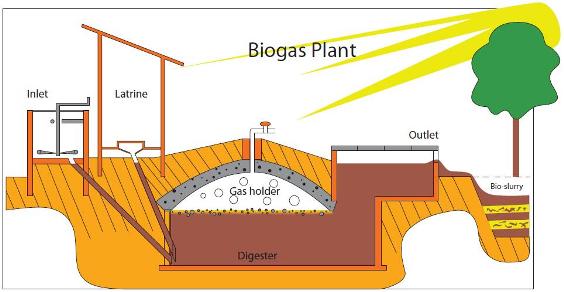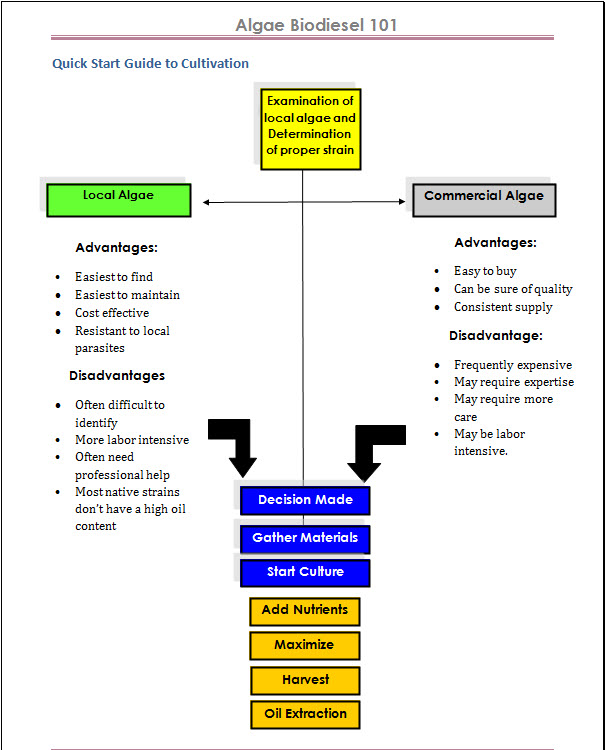Algae Bio-Gas: The "Real" Natural Gas

Algae biogas is actually a mixture of gases, usually carbon dioxide and methane. It is produced by many kinds of algae microorganisms, usually when air or oxygen is absent. (The absence of oxygen is called “anaerobic conditions.”) Animals that eat a lot of plant material, particularly grazing animals such as cattle, produce large amounts of biogas. The biogas is produced not by the cow or elephant, but by billions of microorganisms living in its digestive system. Biogas also develops in bogs and at the bottom of lakes, where decaying organic matter builds up under wet and anaerobic conditions.
Biogas is a Form of Renewable Energy

Flammable biogas can be collected using a simple tank, as shown here. Algae along with animal manure are stored in a closed tank where the gas accumulates. It makes an excellent fuel for cook stoves and furnaces, and can be used in place of regular natural gas, which is a fossil fuel.
Biogas is considered to be a source of renewable energy. This is because the production of biogas depends on the supply of grass, which usually grows back each year. By comparison, the natural gas used in most of our homes is not considered a form of renewable energy. Natural gas formed from the fossilized remains of plants and animals-a process that took millions of years. These resources do not “grow back” in a time scale that is meaningful for humans.
Biogas is not new. People have been using biogas for over 200 years. In the days before electricity, biogas was drawn from the underground sewer pipes in London and burned in street lamps, which were known as “gaslights.” In many parts of the world, biogas is used to heat and light homes, to cook, and even to fuel buses. It is collected from large-scale sources such as landfills and pig barns, and through small domestic or community systems in many villages.
Benefits of Using Algae Biogas
When biogas is used, many advantages arise. In North America, utilization of biogas would generate enough electricity to meet up to three percent of the continent's electricity expenditure. In addition, biogas could potentially help reduce global climate change.
- Storable & Dispatchable: can be assigned to highest value use
- Maximizes Existing Infrastructure: pipelines, storage, generation
- Multiple Uses: electric generation, fuel transportation, end-use appliances/equipment
- Reduces Emissions/flaring, Air Permitting: captures CH4, 21x more potent GHG than CO2
Furthermore, by converting cow manure into methane biogas instead of letting it decompose, we would be able to reduce global warming gases by ninety-nine million metric tons or four percent.
The 30 million rural households in China that have biogas digesters enjoy 12 benefits:
- Saving fossil fuels,
- Saving time collecting firewood,
- Protecting forests,
- Using crop residues for animal fodder instead of fuel,
- Saving money, saving cooking time,
- Improving hygienic conditions,
- Producing high-quality fertilizer,
- Enabling local mechanization and electricity production,
- Improving the rural standard of living,
- Reducing air and water pollution.
Anaerobic Digestion of Whole Algae

The production of algae biogas from the anaerobic digestion of macroalgae, such as Laminaria hyperbore and Laminaria saccharina, is an interesting mode of gaseous biofuel production, and one that receives scant attention in the United States
The use of this conversion technology eliminates several of the key obstacles that are responsible for the current high costs associated with algal biofuels, including drying, extraction, and fuel conversion, and as such may be a cost-effective methodology. Several studies have been carried out that demonstrate the potential of this approach.
A recent study indicated that biogas production levels of 180.4 ml/g-d of biogas can be realized using a two-stage anaerobic digestion process with different strains of algae, with a methane concentration of 65%. If this approach can be modified for the use of microalgae, it may be very effective for situations like integrated wastewater treatment, where algae are grown under uncontrolled conditions using strains not optimized for lipid production.
You might also be interested in...

The Algae Biodiesel Process
The algae biodiesel process is fairly straight-forward, however the devil is in the details. Read More

The Two Biggest Mistakes in Algae Biofuels
Without a doubt, The Two Biggest Mistakes I saw as a biofuel consultant in advanced biofuels were...Read More

Algae Biofuels: Separating Myth From Fact
Lot so wild stories and wild claims being made in the algae biofuels space. Sifting through the flotsam of cyberspace isn't easy... Read More
The Algae Revolution Has Begun
David Sieg provides more than enough information to tackle this process with confidence
I’m not a biodiesel expert, but I would say that in his book, Making Algae Biodiesel at Home, David Sieg provides more than enough information to tackle this process with confidence if you have the inclination to tackle a do-it-yourself project of this magnitude, which will require dedication, patience, and natural skill. He provides concise overviews as well as in-depth resources for understanding the process and its variables, including tips from commercial versions and national labs. The guide covers all aspects required, including selecting, growing, harvesting the algae; and making the biodiesel. Though the process is certainly not easy, David skillfully makes it easy enough that it is within the grasp of doing this at home. His guide is well-organized and well-written, accompanied by abundant illustrations, photos, and diagrams.
New Energy Congress




